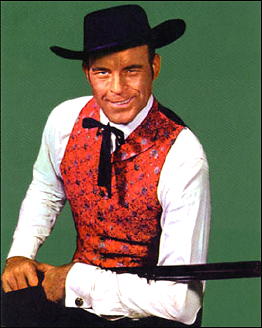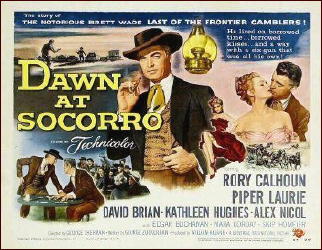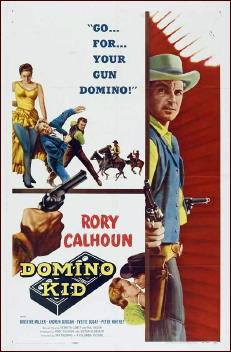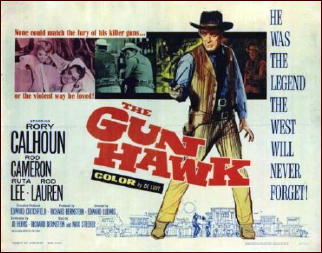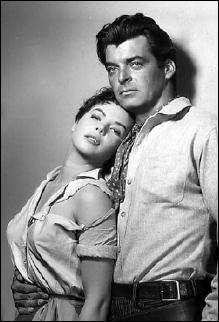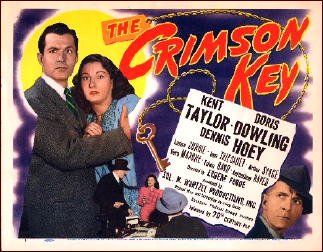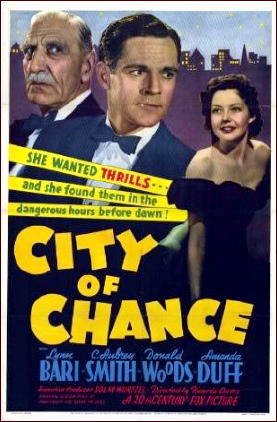April 2012
Monthly Archive
Mon 30 Apr 2012
REVIEWED BY MICHAEL SHONK
SHOTGUN SLADE. Revue Studios/MCA TV. Syndicated, 1959-61, 78 episodes. Created by Frank Gruber. Executive Producer: Nat Holt. Cast: Scott Brady as “Shotgun†Slade.
“Shotgun†Slade (his first name was never mentioned) was the lone member of the Slade Detective Agency, with his office in Denver. He traveled all over the Old West for clients who had hired him.
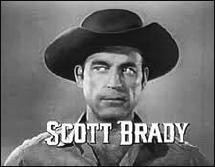
Scott Brady (He Walked by Night) was convincing as a tough Western PI who could handle himself in a fight, but less convincing as Slade the ladies man. Oddly, while he had a beautiful woman waiting for him in virtually every town, Slade thought of himself as a loner.
It was 1959, the PI was beginning to replace the Western on TV, this gimmick heavy syndicated TV series wanted it both ways. Creator Frank Gruber is a familiar name to Pulp and Westerns fans alike. Gruber had worked with Executive Producer Nat Holt on several B-Westerns including The Great Missouri Raid, as well as the TV series Tales of Wells Fargo. Holt is also remembered for his movie work with Randolph Scott (Rage at Dawn). At one point Ralph Dietrich, whose producer credits include a couple of Charlie Chan films, took over as producer from Gruber.
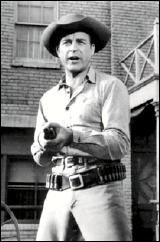
The series was typical of 50s TV-Film syndication. Stories required a least one fight and, as often as possible, for Slade to be knocked out from behind so he could wake up in the care of the beautiful woman of the week.
Slade would narrate over scenes to give exposition so not to slow down the action in this time limited thirty minute PI/Western. The mysteries offered few clues and suspects, but focused on twist after twist until the villain was revealed.
While the locations were pure Western, the stories were more noir PI than the morality plays of TV Westerns. In “Golden Tunnel,†Slade’s old friend and owner of a mine called Slade for help. He was seventy years old and had a young wife he trusted (and shouldn’t) and a nephew he trusted (and shouldn’t) helping him run the place.
There were problems at his mine, someone had taken a shot at him, and, oh by the way, he just discovered the son he thought dead was alive and wanted Slade to make sure his new Will gets to the probate court when he dies, which he does in the next scene.
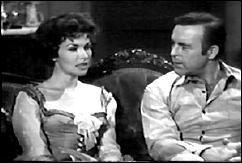
Throughout the series the guest cast was filled with character actors (Alan Hale, Stacy Keach), B-movie favorites (Marie Windsor), and an occasional surprise (Ernie Kovacs).
There is a reason so much of TV-Film syndication from the 50s and 60s look alike. In Storytellers to the Nation: A History of American Television, by Tom Stempel (First Syracuse University Press, 1996), D.C. Fontana (Star Trek) discussed the limitations imposed on writers of half hour TV film syndicated shows established by Ziv and followed by Revue (Universal).
“On
Shotgun Slade a writer was limited to only four major speaking parts, including Slade, and three sets. On the one episode Fontana did, no exteriors were allowed since it was raining and the company could not hold production until it stopped.â€
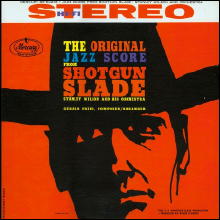
There were countless Westerns and PI shows on the air in 1959. Every series needed something to stand out from the crowd. Shotgun Slade had two obvious gimmicks.
First was his weapon, a gun he had made himself, with a rifle barrel atop a double barrel shotgun. While it had its uses, such as using the barrel to knock the handgun out of the bad guy’s hand, it looked awkward as Slade carried it everywhere he went.
The other gimmick was the jazz soundtrack by Gerald Fried (The Killing). The idea of using jazz music as the soundtrack for a show set in the “Old West†was an interesting but doomed experiment. It proved that no matter how popular the music is at the time of the viewers, the music needs to fit the time of the characters.
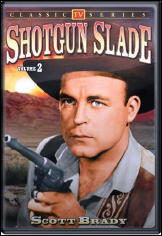
A review in Billboard (8/22/60) gave the soundtrack album (The Original Jazz Score from Shotgun Slade, by Stanley Wilson and his Orchestra; Mercury Records) three out of four stars and said, “…Altho the TV show is a Western, the music is much more closely allied to current ‘private eye’ type, jazz-oriented music than to the old-fashioned Western ditties. It makes for good listening tho it doesn’t have the same melodic appeal of the Mr. Lucky or the Peter Gunn material.â€
Words can not come close to properly describing this song, from an episode of Shotgun Slade, sung by Monica Lewis. (Follow the link.)
Shotgun Slade gave Oscar winning director Sydney Pollack (Out of Africa) his first director job. In The Directors: Take One, Volume One, by Robert J. Emery (Allworth Press 2002), Pollack explained how he got his chance when Shotgun Slade had been cancelled but had a few episodes left to film so they gave him a chance to learn on the job.
The series was popular and, according to Broadcasting (May 30, 1960), it was syndicated in 170 markets. But if you expect Peter Gunn on horseback, you will be disappointed. It had some interesting talent in front and behind the camera, and tried new things with music and drama, but in the end Shotgun Slade offers little (beyond what not to do) worth remembering.
Episodes of Shotgun Slade are available from various DVD sellers and all over the Internet from archives.org to YouTube.
Mon 30 Apr 2012
IT IS PURELY MY OPINION
Reviews by L. J. Roberts
DEBORAH GRABIEN – New Slain Knight. St. Martin’s/Thomas Dunne, hardcover, November 2007.
Genre: Paranormal/Suspense. Leading characters: Ringan Laine/Penny Wintercraft-Hawkes; 5th in “Haunted Ballad” series. Setting: England.
First Sentence: In the large upstairs room at the pub called the Duke of Cornwall’s Own, a local band, the Tin Miners were playing to an enthusiastic audience.
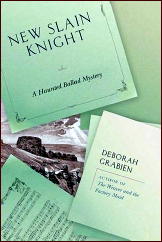
Traditional musician Rupert “Ringan” Laine and theater producer Penny Wintercraft-Hawkes are looking forward to a rare vacation off together. Plans change when Ringan’s sister, whose mother-in-law needs her, asks to send him her 14-year-old daughter, Rebecca, a violin prodigy.
Staying with Gowan, a musician friend in Cornwall, seemed like a good idea until Penny has a vision of a man dying and Becca starts sleep-walking. What are the forces from the past and beyond the grave influencing these two women?
Books that include a cast of characters and a map are such a treat. It is even better that Ms. Grabien’s characters are so distinct and strong that I didn’t need reminding of them, but it’s still a lovely thing to have.
The recurring characters of Ringlan and Penny are now old friends to me, but the author doesn’t assume they are known to every reader. New readers will have no problem learning who they are and uncovering their backstory. I think this is an important thing for an author to do.
The new characters are interesting, and fully dimensional. There is one character, Gowan, you start by liking but the shine dims a bit; for another, Lucy, the reverse is true. It is very well done. Lucy is a particularly interesting character as she is a researcher and a true skeptic — something you don’t usually see in a book with paranormal elements. She is very believable and adds the perfect balance to the story.
Ms. Grabian’s powers of description not only create a sense of place by showing us around Cornwall, but provided us a sense of the characters through their personal environments. When including old documents, I appreciate her leaving them in the appropriate Old English and Victorian spelling and grammar. She trusts the ability of her audience, which is wonderful.
Each of Ms. Grabian’s “Haunted Ballad†books is based on an actual old ballad, with a verse from the ballad at the beginning of each chapter. From that, she constructs a story each with a unique use of the paranormal element and a solidly constructed plot. Just when you think you’ve found a hole, she closes it.
The characters ask the questions you mentally ask, and she answers them. The tension and suspense increase at a steady rate but without ever crossing over into graphic horror. The result is even more frightening than if she had, and then she adds excellent twists.
I thoroughly enjoyed this book and closed it without identifying any flaws in its construction. The only question for potential readers is whether they enjoy books with a paranormal theme. If the answer is yes, I highly recommend New Slain Knight.
Rating: Excellent.
The “Haunted Ballad” mystery series —
1. The Weaver and the Factory Maid (2003)
2. The Famous Flower of Serving Men (2004)
3. Matty Groves (2005)
4. Cruel Sister (2006) [Reviewed here.]
5. New Slain Knight (2007)
Sat 28 Apr 2012
REVIEWED BY DAN STUMPF:
Dawn at Socorro (1954), a thinly-veiled Earp/Clanton drama, covers much of the same ground as OK Corral and Hour of the Gun, with a fraction of the time and pretension. Rory Calhoun is the Doc Holliday figure, Alec Nicol is Johnny Ringo, and Lee Van Cleef is the last surviving Clanton.
There’s a nice bit where Van Cleef arrives at a Swing Station to ambush the stage carrying Calhoun. As the stage draws near, he turns to the Station Man, jacks a round into his Winchester and says something like “My name’s Billy Clanton. Be sure and tell everyone you saw me kill Doc Holliday.”
Footage of Calhoun offing the baddies in this film (Gee, hope I didn’t spoil the suspense!) was later used as flashbacks in Red Sundown (1956), directed by Jack Arnold with his customary flair for violence.
Domino Kid (1957) features Calhoun as the guy out to get the men who killed his parents and looted their ranch while he was off to War. It starts out very fast and interesting, with fine cameos of two of the baddies, played by Roy Barcroft, fatalistically toasting his opponent before the gunfight, and James Griffith, psychotically snarling and justifying his actions as Frontier Law.
This lasts about the first 20 minutes, and then the action just sort of stops. Dead in its tracks. Disappointing, but the first part is still quite nice.
Four Guns to the Border (1954) is a Western Caper film, with Calhoun the head of a gang that includes Jay Silverheels, George Nader, and John McIntire. Their plan is to visit the town that Calhoun was run out of years ago by his erstwhile gunbuddy, the gutless Charles Drake, and rob the bank while everybody’s gathered at the stables watching Calhoun and Drake duke it out.
There’s lots of moody, tenseful waiting around at a Swing Station outside of town, and what looks like a very grim climax indeed — at first.
Calhoun wrote the script for an interesting Western, Shotgun (1955) featuring Sterling Hayden, Zachary Scott and Yvonne De Carlo, but his last good oater was The Gun Hawk, where he’s a wounded, burned-out gunfighter pursued by Sheriff Rod Cameron. In this one he gets the chance to reprise the ending of Four Guns to the Border and bring it to its logical conclusion.
â— DAWN AT SOCORRO. Universal International, 1954. Rory Calhoun, Piper Laurie, David Brian, Kathleen Hughes, Alex Nicol, Edgar Buchanan, Mara Corday, James Millican, Lee Van Cleef. Director: George Sherman.
â— DOMINO KID. Columbia Pictures (1957). Rory Calhoun, Kristine Miller, Andrew Duggan, Yvette Duguay, Peter Whitney, Roy Barcroft, James Griffith (the latter two uncredited). Director: Ray Nazarro.
â— FOUR GUNS TO THE BORDER. Universal International, 1954. Rory Calhoun, Colleen Miller, George Nader, Walter Brennan, Nina Foch, John McIntire, Charles Drake, Jay Silverheels, Nestor Paiva. Based on a story by Louis L’Amour. Director: Richard Carlson.
â— THE GUN HAWK. Allied Artists, 1963. Rory Calhoun, Rod Cameron, Ruta Lee, Rod Lauren, Morgan Woodward, Robert J. Wilke, John Litel. Director: Edward Ludwig.
NOTE: Dan reviewed The Gun Hawk at much greater length here earlier on this blog. Another Rory Calhoun western recently reviewed by Dan was The Silver Whip. This post is a continuation of that one. You may go back and find it here.
Fri 27 Apr 2012
Posted by Steve under
Reviews[5] Comments
BARBARA WORSLEY-GOUGH – Alibi Innings. Michael Joseph, UK, hardcover, 1954. Penguin 1321, UK, paperback, 1958. No US edition.
There have been other mysteries taking place a cricket background, I’m sure, but I’ve never read any of them. I’m also sure that the game is described well in Alibi Innings, but I don’t know how to play cricket, and after reading this book, I still don’t. Readers in the UK would fare the same, I imagine, reading books in which the game of baseball is played.
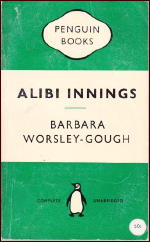
But judge for yourself. Here’s an excerpt, from page 63:
The Burgeon captain had put himself on. He was small, sturdy farmer who bowled leg-spinners with a field set more carefully than was usual with the village bowlers. Cover and extra cover were in the ordinary places, slip was stationed wide for a possible snick, and silly point (the captain’s pink-faced son who still sang soprano in the choir) waited apprehensively only a few inches from the bat…
The vast complexities of living had no place in this microcosm of white on green under blue. The Burgeon captain sent down an easy one, and he [the Squire] turned round the corner to fine leg. They could have run two, but Randall did not hurry.
It’s an idyllic day on a hot summer afternoon, an annual affair, withe Squire Easton’s team taking on the local villagers. It’s too bad that murder has to spoil it, but although it’s not said, it’s clear that Dr. Randall Curtis found the body of Mrs. Easton before the match began, and he said nothing, not to spoill the Squire’s day.
Mrs. Easton is one of those people about whom no one can say any good, an ill-tempered old woman who delighted in flaunting her power over others. And yet, as the author of Alibi Innings, Barbara Worsley-Gough makes us feel the sadness in her passing as no other mystery writer has done in my recent memory. Strangely enough, no one really minds that she is dead, but — if this makes sense — everyone is disturbed that she is no longer there.
There are only a finite number of suspects, though the inevitable cry goes up that it must have been a tramp or a gypsy. While this is a detective story, as must happen more often than not in real life, all of the mysterious clues and other misleading evidence seem to unravel themselves, rather the need of having a mastermind detective to stand up and take charge. More time is spent repairing some unfortunate marriages that are about to take place, and by the end of the story, everyone seems to be relieved that they are not.
According to Hubin, one of Worsley-Gough’s other novels (and there are eight listed inside the front cover of the Penguin editon) is a mystery (Lantern Hill, 1957), and one of the characters (the Squire’s closest friend, Aloysius Kelly) appears in that one as well. He’s not the detective of record in this one, however, making his flamboyant presence widely known in the first half, but fading away in the second.
This is an old-fashioned mystery, one with characters the reader will identify with, even though they no longer exist, and if they did, perhaps only for the shortest period of time and locale.
— Reprinted from Mystery*File 28,
February 1991 (slightly revised).
[UPDATE] 04-27-12. Marv Lachman has written a long article in which he discusses many works of detective fiction in which the game of cricket plays a substantial role. You can find it here on the main Mystery*File website. As for me, even though I wrote this review over 20 years ago, I still have no idea how cricket is played. (It’s nothing I’m proud of. It just is.)
Fri 27 Apr 2012
REVIEWED BY GEOFF BRADLEY:
DIAMOND GEEZER. Granada TV, UK, April 2007. David Jason, Stephen Wight, Gary Whelan. Created by Caleb Ranson.
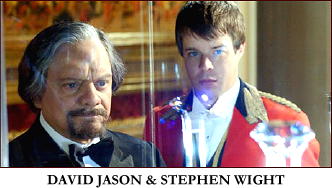
Diamond Geezer was a three part series (90 minutes each, less adverts) to follow up the original programme (20 March 2005). Des (David Jason) is a superior crook with a heart who sets out to accomplish some impossible crimes. They are watchable but ludicrous and certainly not as clever as they profess to be.
For example in the first, where Des steals the world’s largest diamond from Buckingham Palace no less, he has an accomplice press a button on a phone-sized devise which immediately knocks out all the close circuit TV in the Palace. No explanation at all as to what this devise is that can render the security useless or how Des could get one.
Amusing, I suppose, if you want an evening with the brain disengaged.
Editorial Comment: Although not released in the US, all three episodes plus the 2005 pilot are available on DVD in the UK. You need a multi-region player, but the box set should not cost you more than $20, including shipping. I had thought of picking it up, but after reading Geoff’s review, I am much less anxious to do so.
Thu 26 Apr 2012
THE TWELVE BEST ESSAYS ON CRIME FICTION
by Josef Hoffmann
I love to read essays on literature, but above all I love to read essays on crime fiction. During the last 120 years so many essays on crime fiction were written that I have probably read less than five per cent.
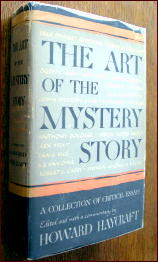
Nevertheless I have put together a list of my favourites. When I talk with booksellers in mystery bookstores in Germany they complain that any kind of reference work does not sell well. The readers of crime fiction just want the pure stuff, the thrill of the stories. They are not interested in information about crime fiction.
This seems to be different with the readers of the Mystery*File blog. There should be some interest in my choice of the twelve best essays on crime fiction. The subjects vary, of course, as crime fiction is a varied genre. For me the ideal literary essay combines the following general features: some useful information, intelligent thought, a good prose style, a little bit of experimentation, and the author’s individual voice must be heard.
Most of these essays may be most easily found in two sources. (*) Reprinted in: Howard Haycraft, editor: The Art of the Mystery Story, and (**) Reprinted in: Ed Gorman, Lee Server, Martin H. Greenberg, editors: The Big Book of Noir.
Here comes the list:
1. “The Simple Art of Murder,” by Raymond Chandler. (*) For me this is one of Chandler’s best texts (texts including novels and short stories), very often quoted.
2. “A Defence of Detective Stories,” by G. K. Chesterton. (*) Chesterton has again and again surprising and brilliant ideas and expresses them in excellent prose.
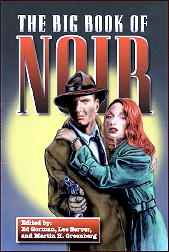
3. Foreword in Patricia Highsmith’s story collection Eleven, by Graham Greene. A very good understanding of Highsmith’s special art of crime writing, precise language, masterful.
4. “The Locked-Room Lecture,” by John Dickson Carr. (*) The famous chapter from the novel The Three Coffins by the undisputed master of the locked-room mystery.
5. “Warning! Warning! Hitchhikers May Be Escaped Lunatics!,” by Stephen King. (**) Very direct and frank, rather personal, full insight into Jim Thompson’s work from the viewpoint of a famous storyteller.
6. “Chester Himes: America’s Black Heartland“, by James Sallis. (**) A fine, informative essay by a literary expert and great crime writer.
7. “The Guilty Vicarage: Notes on the Detective Story, by an Addict,” by W. H. Auden. A very particular view on the subject by the famous poet, in: The Dyer’s Hand and Other Essays.
8. “Forgotten Writers: Gil Brewer,” by Bill Pronzini. (**) An impressive portrait of a once very successful writer of paperback originals whose life ended tragically.
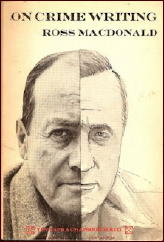
9. “The Writer As Detective Hero,” by Ross Macdonald. A typical Ross Macdonald text, with a lot of psychology and personal reflection, in: On Crime Writing.
10. Introduction to The Hard-Boiled Detective: Stories from Black Mask Magazine 1920-1951, by Herbert Ruhm. A highly informative essay on Black Mask Stories.
11. “Gaudy Night,” by Dorothy L. Sayers. (*) A self-critical and ironic look on the writing process of a detective novelist of the Golden Age.
12. “The Novels of Vin Packer,” by Jon L. Breen, in: Murder Off the Rack: Critical Studies of Ten Paperback Masters, edited by Breen and M. H. Greenberg. A convincing argument for the appreciation of the neglected work of an outstanding writer.
Looking finally at my list I see I have missed many names, for example the names of Anthony Boucher, Patricia Highsmith, Julian Symons, Francis M. Nevins, Marcia Muller, H. R. F. Keating, Fredric Jameson, Ed Gorman, Sara Paretsky, Bill Crider, Mike Ripley and so on. Probably a list with 50 titles would be more adequate.
Thu 26 Apr 2012
REVIEWED BY WALTER ALBERT:
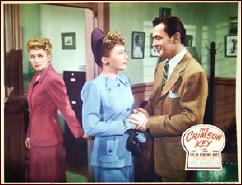
THE CRIMSON KEY. 20th Century Fox, 1947. Kent Taylor, Doris Dowling, Dennis Hoey, Louise Currey, Ivan Triesault, Bernadene Hayes, Victor Sen Young. Original story and screenplay: Irving Elman. Director: Eugene Forde. Shown at Cinevent 39, Columbus OH, May 2003.
This “B” film, independently produced by Sol Wurtzel for release by Fox back in 1947, was an entertaining (if somewhat muddled) crime drama, with Kent Taylor as private eye Larry Morgan attempting to sort out the conflicting loyalties (and dubious innocence) of the various characters (mostly women) who keep hiring him for what turn out to be motives that don’t make him a great favorite of the police.
It was fun to see Dennis Hoey, the befuddled Lestrade of the Sherlock Holmes series, as a befuddled husband, and Victor Sen Young, buried at the bottom of a very long list of credits (from which I resurrected him), registers strongly as a faithful, possibly sinister Oriental servant.
Kent Taylor’s crisp performance, dotted with breezy one-liners, validated his star billing, and Doris Dowling, Bernadene Hayes, and Louise Currie, played (respectively) two women who hire Taylor, and his faithful, seldom paid secretary.
Wed 25 Apr 2012
THE BACKWARD REVIEWER
William F. Deeck
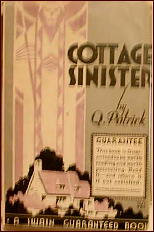
Q. PATRICK – Cottage Sinister. Roland Swain Co., hardcover, 1931. Popular Library #386, paperback, 1951.
In the village of Crosby-Stourton in a charming cottage called Lady’s Bower lives Mrs. Lubbock with one of her daughters, a nurse. Two other daughters are visiting and die of hyoscine poisoning. A fair number of people had the opportunity, several had the means, but a motive is difficult to find.
Archibald Inge, better known as the Archdeacon because of his resemblance to a Hound of Heaven rather than an earthly sleuth, is brought down from Scotland Yard to investigate. The Archdeacon is “an expert at psychological crimes because he never used his imagination — an adept in motiveless murder because he firmly believed that there was no such thing.” Thus, he was adroit at solving mysteries because he never thought anything mysterious.
Two more deaths occur after the Archdeacon arrives in the village. It is obvious to him near the end of the investigation who did it. Unfortunately, he is mistaken. Still, he should have realized that the motive he attributed to the suspect was nonsensical.
A well-written and amusing mystery, though the clues leave something to be desired. The Archdeacon is a fascinating character.
— From The MYSTERY FANcier, Vol. 11, No. 1, Winter 1989.
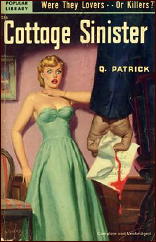
Bibliographic Notes: The tangle of names behind the “Q. Patrick” pen name is as bad as the mess of cables hidden behind my computer. Most of the books written under that byline were by Richard Wilson Webb and Hugh Callingham Wheeler. Cottage Sinister, along with one other, was written by Webb and Martha Mott Kelley. Two other books were done by Webb in collaboration with Mary Louise Aswell.
At another time and another day, an explanation of where Patrick Quentin and Jonathan Stagge also fit into the picture would be well worth doing, but for now, I’ll let Google do what it does best. While I haven’t checked it for completeness, here is a website that comes up early in the search, is organized very well, and should prove to be helpful to anyone who’s new to the author.
Unless something has slipped by Al Hubin, this was the only appearance of Archibald Inge, the “Archdeacon.”
Wed 25 Apr 2012
A 1001 MIDNIGHTS Review
by Bill Pronzini
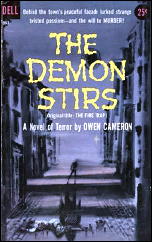
OWEN CAMERON – The Fire Trap. Simon & Schuster, hardcover, 1957. Also published as The Demon Stirs: Dell #983, paperback, 1958.
Owen Cameron is one of those talented but unfortunate writers whose work generates a small commotion when first published but for some inexplicable reason is forgotten while lesser writers achieve recognition and a large following. A successful magazine writer, Cameron published seven criminous novels; the last four of these constitute some of the most quietly compelling suspense fiction of the 1950s.
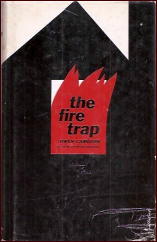
The protagonist of The Fire Trap is Deputy Sheriff Jake Brown of the northern California mountain community of Verdi, who is also featured in Cameron’s best-known novel, Catch a Tiger (1952). Jake’s job here is a grim and ugly one: to find out who is responsible for a series of arson fires, the latest of which claimed the lives of two young children.
Matters turn even deadlier when an outsider, insurance-claims adjuster Hal Moss, is found shotgunned to death on a back country road, One of the suspects in both crimes is Jake’s own father, a surly old toner who has been estranged from Jake for fourteen long, bitter years. Other suspects include Jake’s brother, Art; one of his best friends, Floyd Rupert; and a woman with whom he was once involved, Alice Newsom.
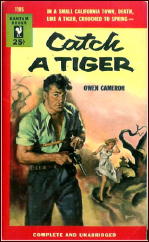
“In his stubborn, honest, relentless way,” the dust jacket blurb says, “Jake follows his hunches and tracks down his suspicions … At every turn [he] is met by his own sense of guilt and frustration-feelings intensified when he realizes that he has unwittingly set the scene for two more murders.” It is at terrible personal cost that he eventually arrives at the truth, in a series of climaxes that can only be described as shattering.
This is provocative stuff, told in lean, understated prose that makes it all the more forceful. As is the case with Catch a Tiger and two non-series books, The Butcher’s Wife (1954) and The Silent One (1958), it is a novel that has disturbing things to say about the dark side of human relationships.
———
Reprinted with permission from 1001 Midnights, edited by Bill Pronzini & Marcia Muller and published by The Battered Silicon Dispatch Box, 2007. Copyright © 1986, 2007 by the Pronzini-Muller Family Trust.
Bibliographic Note: A partial list of Owen Cameron’s short fiction can be found here on the Fiction Mags Index. His first recorded story was for Collier’s in 1943. Collier’s was a “slick magazine,” but Cameron can be considered a pulp writer, too, since his list of credits also includes stories published in Blue Book and Argosy.
Tue 24 Apr 2012
CITY OF CHANCE. 20th Century Fox, 1940. Lynn Bari, C. Aubrey Smith, Donald Woods, Amanda Duff, June Gale, Richard Lane, Robert Lowery, Alexander D’Arcy. Director: Ricardo Cortez.
If you know more than the first three names listed in the credits above, you ought to be given a prize for being a 1940s B-movie connoisseur extraordinaire! And in all honesty, most movie-goers today will not even recognize the first three, and this in spite of the fact that in total their combined list of TV and movie credits on IMDB adds up to 412. Not too shabby!
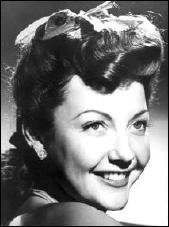
Of the threesome, it is the best-looking who has the most: Lynn Bari, with 166. (I hope there is no argument as to whether or not she was the best looking.) A dark-haired brunette, she was in tons of B-movies in the 1940s, but to my mind she had the talent (and good looks) to have made the jump to A-status, but for some reason, she never really did.
I remember her from her days on TV in the 1950s, and a comedy series I’m sure she was in. It must have been one called Boss Lady, on for 12 episodes on NBC in 1952, according to IMDB, but since I was only ten or so at the time, I’m not sure about that. (It is possible that she made such a favorable impression on me, even at that early age, that I remember her from it even today. She was very good-looking.)
To the film at hand. City of Chance is only 56 minutes long, but in its length it takes in all of the events that take place in one “ordinary†night in an afterhours (and strictly illegal) casino somewhere in the US. (The town may have been named, but if so, it has slipped my memory.)
The owner is one Steve Walker (Donald Woods), but the real brains behind him is “The Judge†(C. Aubrey Smith), a long-time confirmed gambler who has taken the younger man under his wing. Lynn Bari plays a lady reporter with a nose for news who’s made her way into the place under a false identity. She also has, we soon discover, plans to call in the D.A. and the cops (and her news editor) when she has the evidence she needs to have the gambling place raided.
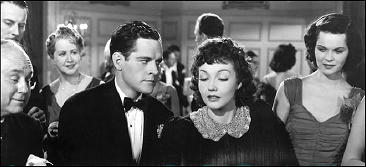
Turns out, though, that she and Walker were childhood sweethearts, and part of her motivation in closing him down may be that she is still sweet on him and she has personal reasons for wanting him out of the gambling business for good. Things are a little fuzzy in this regard, as they often are in romantic comedies from the 30s and 40s, but I know I’m 99% right on this.
Also occurring on this night in question is what happens when Walker turns down a notorious gambler who wants to take over the operation, what happens when a shot rings out, what happens when one half of a newly married couple learns that a blackmailer has certain letters of hers to him, and what happens when the lady reporter learns that she is not allowed to…
I’ll stop here. As alluded to above, there is as much comedy, of the screwball variety, as there is noir in this film, but I don’t believe that either of the two was the overall intent. The movie’s primary purpose was to be entertaining, and without a overabundance of production values, that’s exactly what Chance in the City is.
But it’s even better with Lynn Bari in it.
Next Page »





